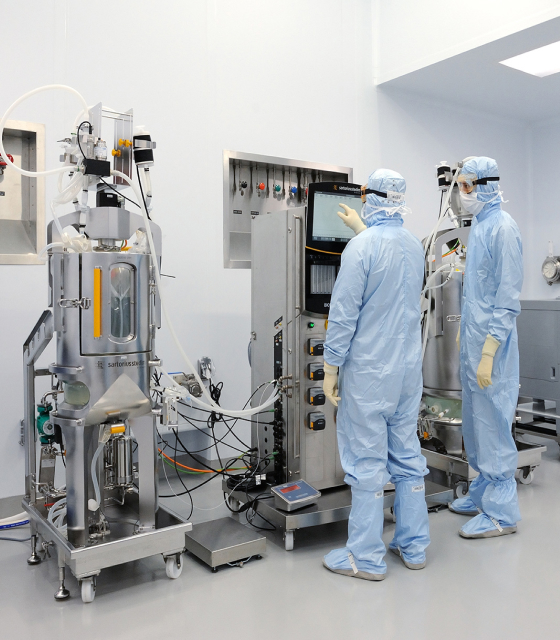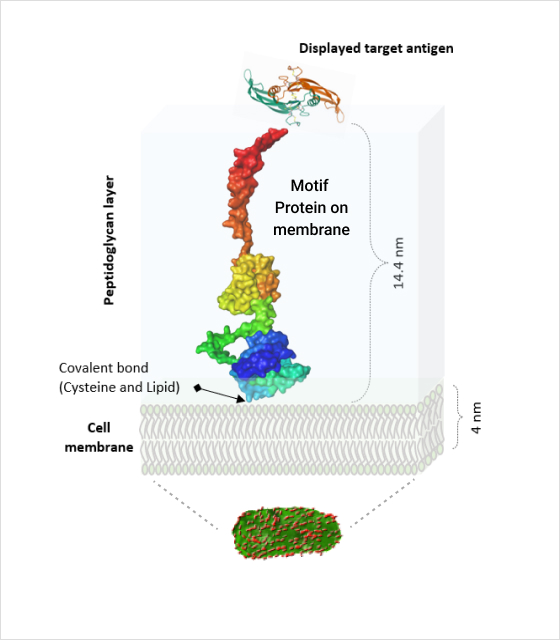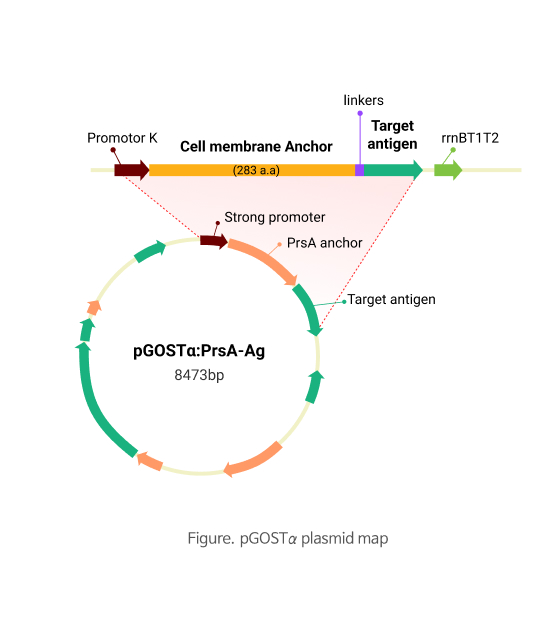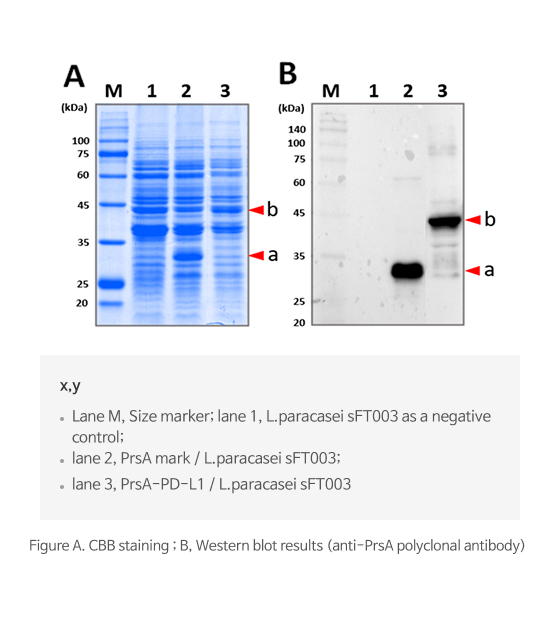Core Technology
GRAS microbial cell surface expression technology
(GOST)
GRAS micro-Organism Surface-display Technique
A technology that recombines a linker-connected target antigen gene to the gene of the motif membrane protein present on the cell surface of lactic acid bacteria, enabling chimeric expression of the gene on the microbial surface.
GOST Key Features
-
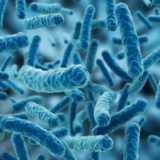
GRAS bacteria & probiotics
Use of a safe and well-documented Lacticaseibacillus paracasei,
a probiotic strain derived from Kkadugi,
as the carrier for target antigen peptides or proteins. -

Firmly secures the target antigen on the cell wall
A technology to combine the extracellular lipoprotein gene of Latilactobacillus sakei, a probiotic strain derived from gat-kimchi, and the target antigen gene, allowing the chimeric expression of a fused protein on the extracellular surface of the bacteria. -

Making of self-proteins
Incorporates parts of the target antigen gene as specific linkers,
disabling immune recognition of self-proteins.
GOST – Its Three Core Technologies
01Probiotics as antigen protein carriers
Probiotic bacterium as a vector for target antigen protein delivery
-
Name of host
Lacticaseibacillus paracasei -
Source
Lacticaseibacillus paracasei sFT003 & sFT026, isolated from kkadugi from Masan, Gyeongsangnam-do.
- Probiotics isolated from kkadugi
- Safety certified antigen delivery system using GRAS bacterium
- Wild-type strains that can be genetically modified
- Enhanced production efficiency with rapid proliferation
- Minimized production cost with conventional cultivation methods and simple production process
- Maintains a stable cellular structure following sterilization
- Higher safety and efficacy compared to subunit or split vaccines
02Anchor protein motif for cell surface expression of antigen proteins
Anchor lipoprotein motif on cell surface for combination with target antigens
-
Anchor lipoprotein name
Extracellular membrane lipoprotein PrsA -
Source
Isolated from the extracellular membrane of Latilactobacillus sakei, a strain found in gat-kimchi from Gyeongnam region of Korea
- Probiotic cell membrane lipoprotein isolated from gat-kimchi
- Anchor protein expressed in GRAS bacteria, certified to be non-toxic and safe
- Extracellular membrane protein stably expressed in large-scale in the probiotic cell wall
- Stable membrane surface expression through covalent bonds with membrane lipids
- Low amino acid sequence homology with functionally similar proteins in the antigen carrier probiotic host (allows easy research and development)
- A protein structure that spans across the peptidoglycan layer of the bacteria’s outer cell wall
03A vector system enabling large-scale antigen protein expression on the outer membrane surface
A probiotic-derived cell surface target protein expression system
-
Probiotic-derived vector system
pAMß backbone -
A high-expression promoter derived from probiotic bacteria
Identification of mass-expressed extracellular membrane proteins and their promoters in Latilactobacillus sakei based on extracellular protein shaving technique using Lys-C protease
- Simple gene replacement with target antigen protein genes via genetic recombination (Mock-up technique)
- Pandemic response technology that allows quick responses to mutations of the antigen gene
- Trypsin, Lys-C enzyme, and nano-LC coupled MS / Identification of mass-expressed Latilactobacillus sakei outer membrane proteins by using MS analysis, and securing of promoter that regulates biosynthesis
- Able to induce stable and large-scale expression of target antigen protein on the outer cell mebrane of the probiotic host, Lacticaseibacillus paracasei
- CBB staining confirms the strong-expression promoters for outer membrane surface expression
GOST Applications
- The GOST technology enables stable surface expression of enzymes, peptides, and proteins on the outer membrane of probiotic bacteria.
- When enzymes are expressed on the bacterial surface, this can be used as biocatalysts in bioconversion processes to produce high-value biomaterials.
When expressing peptides or proteins on the cell surface as target antigens
- 1The surface expression of viral or bacterial antigens can allow the development of preventive and therapeutic vaccines.
- 2When expressing all of the self-proteins or their antigenic regions on the cell surface, these can allow the development of cancer immunotherapy, metabolic disease treatments, and autoimmune disease therapies.
Advantages of GOST technology
-
Induces immune responses to a wide range of antigens (including self-proteins)
-
Strength of immune responses to vaccine types
live-attenuated > inactivated > split > subunit -
Induces both humoral (antibody-mediated) and cellular immune responses
-
Low production cost and rapid manufacturing process
(enables quick responses to pandemics) -
A cassette-type design mock-up vaccine technology
Cookie notice
By clicking 'Accept all cookies', you agree to the storing of cookies on your device and to the associated processing of data to enhance site navigation, analyse site usage, and assist in our marketing and performance efforts.
Cookie Consent Settings
- Strictly Necessary Cookies
- Functional Cookies
- Marketing/Advertising Cookies
- Statistics Cookies

